
BASIC is a family of general-purpose, high-level programming languages designed for ease of use. The original version was created by John G. Kemeny and Thomas E. Kurtz at Dartmouth College in 1963. They wanted to enable students in non-scientific fields to use computers. At the time, nearly all computers required writing custom software, which only scientists and mathematicians tended to learn.

GW-BASIC is a dialect of the BASIC programming language developed by Microsoft from IBM BASICA. Functionally identical to BASICA, its BASIC interpreter is a fully self-contained executable and does not need the Cassette BASIC ROM found in the original IBM PC. It was bundled with MS-DOS operating systems on IBM PC compatibles by Microsoft.

Microsoft QuickBASIC is an Integrated Development Environment and compiler for the BASIC programming language that was developed by Microsoft. QuickBASIC runs mainly on DOS, though there was also a short-lived version for the classic Mac OS. It is loosely based on GW-BASIC but adds user-defined types, improved programming structures, better graphics and disk support and a compiler in addition to the interpreter. Microsoft marketed QuickBASIC as the introductory level for their BASIC Professional Development System. Microsoft marketed two other similar IDEs for C and Pascal, viz QuickC and QuickPascal.
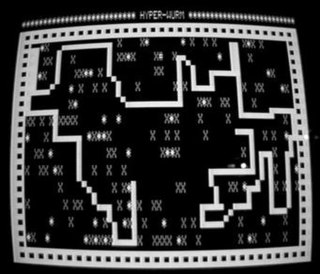
Snake is a sub-genre of action video games where the player maneuvers the end of a growing line, often themed as a snake. The player must keep the snake from colliding with both other obstacles and itself, which gets harder as the snake lengthens. It originated in the 1976 two-player arcade video game Blockade from Gremlin Industries where the goal is to survive longer than the other player. The concept evolved into a single-player variant where a snake gets longer with each piece of food eaten—often apples or eggs. The simplicity and low technical requirements of snake games have resulted in hundreds of versions—some of which have the word snake or worm in the title—for many platforms.
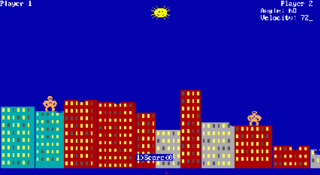
Gorillas, also known under the source code's file name GORILLA.BAS, is a video game first distributed with MS-DOS 5 and published in 1991 by Microsoft. It is a turn-based artillery game. With allusions to King Kong, the game consists of two gorillas throwing explosive bananas at each other above a city skyline. The players can adjust the angle and velocity of each throw as well as the gravitational pull of the planet.

Rampart is a 1990 video game released by Atari Games and Midway Games that combines the shoot 'em up, strategy, and puzzle genres. It debuted as an arcade game with trackball controls, and was ported to home systems. It had a limited US release in October 1990, and a wide release in early 1991. It was distributed in Japan by Namco.
Donkey, often known by its filename DONKEY.BAS, is a video game written in 1981, and included with early versions of the IBM PC DOS operating system distributed with the original IBM PC. It is a top-down driving game in which the player must avoid hitting donkeys. The game was written by Microsoft co-founder Bill Gates and early employee Neil Konzen.

MS-DOS Editor, commonly just called edit or edit.com, is a TUI text editor that comes with MS-DOS 5.0 and later, as well as all 32-bit x86 versions of Windows, until Windows 11. It supersedes edlin, the standard editor in earlier versions of MS-DOS. In MS-DOS, it was a stub for QBasic running in editor mode. Starting with Windows 95, MS-DOS Editor became a standalone program because QBasic didn't ship with Windows.
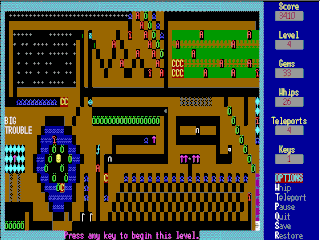
Kroz is a series of Roguelike video games created by Scott Miller for IBM PC compatibles. The first episode in the series, Kingdom of Kroz, was released in 1987 as Apogee Software's first game. It was also published on Big Blue Disk #20. Kroz introduced the scheme of the first episode being free and charging money for additional episodes; a technique which defined the business model for Apogee and was adopted by other MS-DOS shareware publishers.

The Faery Tale Adventure is a 1987 action role-playing video game designed by David Joiner and published by MicroIllusions for the Amiga, and later ported to the Commodore 64, MS-DOS, and Sega Genesis. The MS-DOS version is titled The Faery Tale Adventure: Book I. Microillusions also released a "Book 1" version for the Amiga which was going to be the start of a series of games, according to Talin, but bankruptcy prevented it. The initial version was produced for the Amiga 1000 and featured the largest game world to that date. A sequel, Faery Tale Adventure II: Halls of the Dead, was released in 1997.
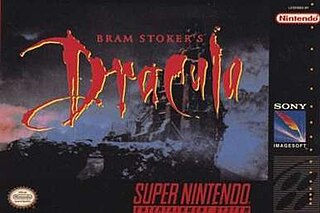
Bram Stoker's Dracula is a 1993 video game released for the Mega Drive/Genesis, Nintendo Entertainment System, Super NES, Game Boy, Master System, Sega CD, Game Gear, MS-DOS, and Amiga. It is based on the 1992 film Bram Stoker's Dracula which in turn is based on the 1897 novel Dracula by Bram Stoker. Most versions are platform games. The Sega CD and Amiga releases are beat 'em ups, and the MS-DOS version is a first-person shooter. The Amiga version was released in 1994 for North America and Europe. A CD-ROM version for MS-DOS compatible operating systems was released in 1995.

Disney's The Jungle Book is a series of platform video games based on the 1967 Disney animated film of the same name. The game was released by Virgin Interactive Entertainment in 1994 for the Game Boy, Nintendo Entertainment System, Master System, Genesis/Mega Drive, Game Gear, Super Nintendo Entertainment System, and MS-DOS. While gameplay is the same on all versions, technological differences between the systems forced changes – in some case drastic – in level design, resulting in six fairly different versions of the 'same' game. This article is largely based upon the Genesis version.
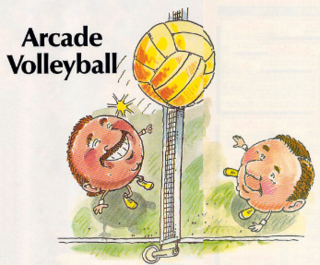
Arcade Volleyball is a sports video game written by Rhett Anderson for the Commodore 64 and published as a type-in program in the June 1988 issue of COMPUTE!'s Gazette. It was ported to Amiga and MS-DOS by different programmers and was included in a 12-game collection called Best Gazette Games. The author released the game later into the public domain.

Advanced Dungeons & Dragons: Treasure of Tarmin is a video game for the Intellivision video game console and the Mattel Aquarius computer system. This game was a licensed Dungeons & Dragons adaptation. It is a successor game to Advanced Dungeons & Dragons: Cloudy Mountain (1982).
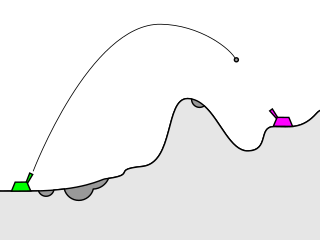
Artillery games are two or three-player video games involving tanks trying to destroy each other. The core mechanics of the gameplay is almost always to aim at the opponent(s) following a ballistic trajectory. Artillery games are among the earliest computer games developed; the theme of such games is an extension of the original uses of computer themselves, which were once used to calculate the trajectories of rockets and other related military-based calculations. Artillery games have been described as a type of "shooting game", though they are more often classified as a type of strategy video game.

QB64 is a self-hosting BASIC compiler for Microsoft Windows, Linux and Mac OS X, designed to be compatible with Microsoft QBasic and QuickBASIC. QB64 is a transpiler to C++, which is integrated with a C++ compiler to provide compilation via C++ code and GCC optimization.

QBasic is an integrated development environment (IDE) and interpreter for a variety of dialects of BASIC which are based on QuickBASIC. Code entered into the IDE is compiled to an intermediate representation (IR), and this IR is immediately executed on demand within the IDE.
The IBM Personal Computer Basic, commonly shortened to IBM BASIC, is a programming language first released by IBM with the IBM Personal Computer, Model 5150 in 1981. IBM released four different versions of the Microsoft BASIC interpreter, licensed from Microsoft for the PC and PCjr. They are known as Cassette BASIC, Disk BASIC, Advanced BASIC (BASICA), and Cartridge BASIC. Versions of Disk BASIC and Advanced BASIC were included with IBM PC DOS up to PC DOS 4. In addition to the features of an ANSI standard BASIC, the IBM versions offered support for the graphics and sound hardware of the IBM PC line. Source code could be entered with a full-screen editor, and limited facilities were provided for rudimentary program debugging. IBM also released a version of the Microsoft BASIC compiler for the PC concurrently with the release of PC DOS 1.10 in 1982.
Scetlander was a software publisher which released titles for various 8- and 16-bit home computer systems in the 1980s and 1990s.

















